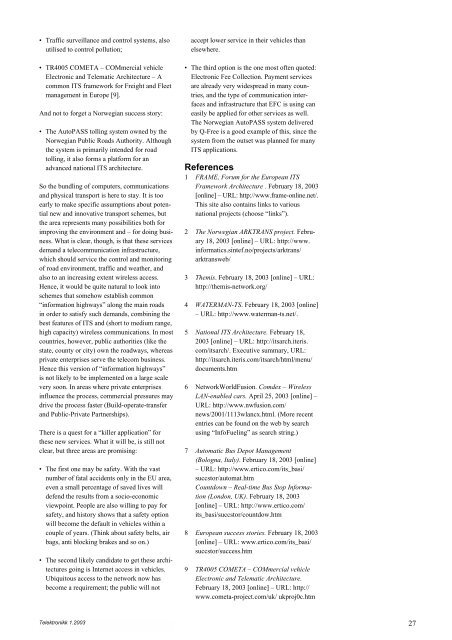Intelligent Transport Systems - Telenor
Intelligent Transport Systems - Telenor
Intelligent Transport Systems - Telenor
You also want an ePaper? Increase the reach of your titles
YUMPU automatically turns print PDFs into web optimized ePapers that Google loves.
• Traffic surveillance and control systems, also<br />
utilised to control pollution;<br />
• TR4005 COMETA – COMmercial vehicle<br />
Electronic and Telematic Architecture – A<br />
common ITS framework for Freight and Fleet<br />
management in Europe [9].<br />
And not to forget a Norwegian success story:<br />
• The AutoPASS tolling system owned by the<br />
Norwegian Public Roads Authority. Although<br />
the system is primarily intended for road<br />
tolling, it also forms a platform for an<br />
advanced national ITS architecture.<br />
So the bundling of computers, communications<br />
and physical transport is here to stay. It is too<br />
early to make specific assumptions about potential<br />
new and innovative transport schemes, but<br />
the area represents many possibilities both for<br />
improving the environment and – for doing business.<br />
What is clear, though, is that these services<br />
demand a telecommunication infrastructure,<br />
which should service the control and monitoring<br />
of road environment, traffic and weather, and<br />
also to an increasing extent wireless access.<br />
Hence, it would be quite natural to look into<br />
schemes that somehow establish common<br />
“information highways” along the main roads<br />
in order to satisfy such demands, combining the<br />
best features of ITS and (short to medium range,<br />
high capacity) wireless communications. In most<br />
countries, however, public authorities (like the<br />
state, county or city) own the roadways, whereas<br />
private enterprises serve the telecom business.<br />
Hence this version of “information highways”<br />
is not likely to be implemented on a large scale<br />
very soon. In areas where private enterprises<br />
influence the process, commercial pressures may<br />
drive the process faster (Build-operate-transfer<br />
and Public-Private Partnerships).<br />
There is a quest for a “killer application” for<br />
these new services. What it will be, is still not<br />
clear, but three areas are promising:<br />
• The first one may be safety. With the vast<br />
number of fatal accidents only in the EU area,<br />
even a small percentage of saved lives will<br />
defend the results from a socio-economic<br />
viewpoint. People are also willing to pay for<br />
safety, and history shows that a safety option<br />
will become the default in vehicles within a<br />
couple of years. (Think about safety belts, air<br />
bags, anti blocking brakes and so on.)<br />
• The second likely candidate to get these architectures<br />
going is Internet access in vehicles.<br />
Ubiquitous access to the network now has<br />
become a requirement; the public will not<br />
Telektronikk 1.2003<br />
accept lower service in their vehicles than<br />
elsewhere.<br />
• The third option is the one most often quoted:<br />
Electronic Fee Collection. Payment services<br />
are already very widespread in many countries,<br />
and the type of communication interfaces<br />
and infrastructure that EFC is using can<br />
easily be applied for other services as well.<br />
The Norwegian AutoPASS system delivered<br />
by Q-Free is a good example of this, since the<br />
system from the outset was planned for many<br />
ITS applications.<br />
References<br />
1 FRAME, Forum for the European ITS<br />
Framework Architecture . February 18, 2003<br />
[online] – URL: http://www.frame-online.net/.<br />
This site also contains links to various<br />
national projects (choose “links”).<br />
2 The Norwegian ARKTRANS project. February<br />
18, 2003 [online] – URL: http://www.<br />
informatics.sintef.no/projects/arktrans/<br />
arktransweb/<br />
3 Themis. February 18, 2003 [online] – URL:<br />
http://themis-network.org/<br />
4 WATERMAN-TS. February 18, 2003 [online]<br />
– URL: http://www.waterman-ts.net/.<br />
5 National ITS Architecture. February 18,<br />
2003 [online] – URL: http://itsarch.iteris.<br />
com/itsarch/. Executive summary, URL:<br />
http://itsarch.iteris.com/itsarch/html/menu/<br />
documents.htm<br />
6 NetworkWorldFusion. Comdex – Wireless<br />
LAN-enabled cars. April 25, 2003 [online] –<br />
URL: http://www.nwfusion.com/<br />
news/2001/1113wlancx.html. (More recent<br />
entries can be found on the web by search<br />
using “InfoFueling” as search string.)<br />
7 Automatic Bus Depot Management<br />
(Bologna, Italy). February 18, 2003 [online]<br />
– URL: http://www.ertico.com/its_basi/<br />
succstor/automat.htm<br />
Countdown – Real-time Bus Stop Information<br />
(London, UK). February 18, 2003<br />
[online] – URL: http://www.ertico.com/<br />
its_basi/succstor/countdow.htm<br />
8 European success stories. February 18, 2003<br />
[online] – URL: www.ertico.com/its_basi/<br />
succstor/success.htm<br />
9 TR4005 COMETA – COMmercial vehicle<br />
Electronic and Telematic Architecture.<br />
February 18, 2003 [online] – URL: http://<br />
www.cometa-project.com/uk/ ukproj0c.htm<br />
27
















